Did you know that Kazakhstan is leading the way in biodiversity conservation and sustainable construction practices? This Central Asian country is making significant strides in integrating urban development and wildlife preservation, all while prioritizing green building initiatives. Aiming to generate 30% of domestic electricity from renewable sources by 2030, Kazakhstan is committed to creating a sustainable future.
Key Takeaways:
- Kazakhstan is at the forefront of a green revolution, focusing on sustainable construction and eco-conscious design.
- The Kazakhstan Green Building Council collaborates with the United Nations Development Program to develop green building standards.
- The Park View Office and Q-2 building have received BREEAM certification for their sustainable construction practices.
- Kazakhstan is actively involved in biodiversity conservation efforts, establishing protected areas and implementing ecosystem approaches.
- The integration of green construction technologies in Kazakhstan’s buildings offers benefits such as energy efficiency and minimized environmental impact.
The Green Building Revolution in Kazakhstan
Kazakhstan is spearheading a green revolution in Central Asia, placing a strong emphasis on sustainable architecture and eco-conscious design. As part of this commitment, the government has set a target to generate 30% of its domestic electricity from renewable sources by 2030. To achieve this goal, the Kazakhstan Green Building Council (KazBC) is collaborating closely with the United Nations Development Program (UNDP) to develop green building standards and promote sustainable architecture throughout the country.
One notable achievement in this green building revolution is the Park View Office, which became the first building in Central Asia to receive BREEAM certification, an internationally recognized mark of sustainable construction practices. This accomplishment highlights Kazakhstan’s dedication to incorporating eco-friendly initiatives into its buildings. Another remarkable example is the Q-2 building, also BREEAM-certified, further solidifying Kazakhstan’s achievements in sustainable construction.
The Role of the European Bank for Reconstruction and Development (EBRD)
“The European Bank for Reconstruction and Development (EBRD) has been a crucial supporter of Kazakhstan’s green economy drive. Through financial assistance and expertise, the EBRD has played a significant role in promoting sustainable development in the country.”
The collaboration between KazBC, UNDP, and the EBRD highlights the comprehensive approach Kazakhstan is taking towards the green building revolution. By combining international standards, local expertise, and financial support, Kazakhstan is paving the way for sustainable architecture and design in the region.
| Key Achievements |
Benefits |
| BREEAM-certified buildings: Park View Office, Q-2 building |
– Reduced environmental impact
– Enhanced energy efficiency
– Positive contribution to the green economy |
| Kazakhstan Green Building Council (KazBC) |
– Development of green building standards
– Promotion of sustainable architecture |
| United Nations Development Program (UNDP) collaboration |
– Support for sustainable construction practices
– Green building initiatives |
| European Bank for Reconstruction and Development (EBRD) support |
– Financial assistance for green projects
– Expertise in sustainable development |
Kazakhstan’s green building revolution is a testament to the country’s commitment to creating a sustainable future. Through sustainable architecture, eco-conscious design, and the integration of renewable energy sources, Kazakhstan is leading the way towards a greener and more sustainable built environment.
Green Construction Technologies in Kazakhstan
Kazakhstan’s top green buildings leverage state-of-the-art green construction technologies and environmentally friendly architectural designs to maximize energy efficiency and minimize the environmental footprint. These innovative techniques and materials are at the forefront of sustainable development in the country.
Energy-efficient systems play a pivotal role in reducing energy consumption and promoting cost savings. Passive heating and cooling systems, along with smart energy management systems, are implemented to optimize energy usage throughout the building’s lifecycle. By harnessing natural resources and deploying smart technologies, these building systems contribute to a greener and more sustainable future.
Another key aspect of green buildings in Kazakhstan is the utilization of sustainable materials. From locally sourced materials to recycled components, the emphasis is on minimizing the carbon footprint and promoting a circular economy. These sustainable materials not only reduce environmental impact but also contribute to the overall durability and longevity of the structures.
Furthermore, environmentally friendly designs are integral to Kazakhstan’s green buildings. These designs prioritize elements such as natural lighting, ventilation, and the integration of green spaces. By embracing these features, buildings can reduce reliance on artificial lighting and mechanical ventilation systems, creating a healthier and more comfortable indoor environment for occupants.
Overall, the adoption of green construction technologies, energy-efficient systems, sustainable materials, and environmentally friendly designs showcases Kazakhstan’s commitment to sustainable development and its efforts to promote a greener built environment.

Benefits of Green Construction Technologies
The integration of green construction technologies in Kazakhstan’s top green buildings offers numerous benefits. These technologies focus on energy-efficient systems, sustainable materials, and environmentally friendly designs, resulting in positive impacts on both the environment and the occupants of these buildings.
1. Energy Efficiency
One of the key benefits of green construction technologies is the implementation of energy-efficient systems. These systems reduce energy consumption, leading to significant cost savings for building owners and occupants. By optimizing energy usage, green buildings contribute to a more sustainable future by reducing greenhouse gas emissions and dependence on non-renewable energy sources.
2. Sustainable Materials
Green buildings prioritize the use of sustainable materials. These materials are sourced responsibly, taking into consideration environmental impacts, social factors, and resource depletion. By selecting sustainable materials such as recycled or locally sourced materials, green buildings minimize their carbon footprint and promote circular economy principles. This not only reduces waste but also supports the development of a more sustainable construction industry.
3. Environmentally Friendly Designs
Green buildings incorporate environmentally friendly designs that optimize natural lighting and ventilation, integrate green spaces, and improve aesthetics. Natural lighting reduces the need for artificial lighting, reducing energy consumption and creating a more comfortable indoor environment. Proper ventilation systems enhance air quality and contribute to a healthier living and working environment. The integration of green spaces within the building design improves overall well-being and promotes a connection with nature.
To illustrate the benefits of green construction technologies, consider the example of the Park View Office in Kazakhstan. This building has successfully implemented energy-efficient systems, sustainable materials, and environmentally friendly designs, resulting in reduced energy consumption, a smaller carbon footprint, and enhanced occupant comfort.
The integration of green construction technologies in Kazakhstan’s top green buildings offers numerous benefits. Energy-efficient systems reduce energy consumption, resulting in cost savings and enhanced comfort for occupants. Sustainable materials minimize the carbon footprint, promote circular economy principles, and minimize waste. Environmentally friendly designs optimize natural lighting and ventilation, integrate green spaces, and improve aesthetics.
When comparing the environmental impact and occupant experience of green buildings versus conventional buildings, the advantages of green construction technologies become clear. The use of energy-efficient systems, sustainable materials, and environmentally friendly designs contribute to a more sustainable built environment and a better quality of life for occupants.
| Benefits of Green Construction Technologies |
Conventional Buildings |
Green Buildings |
| Energy Consumption |
Higher energy consumption |
Reduced energy consumption |
| Carbon Footprint |
Larger carbon footprint |
Smaller carbon footprint |
| Occupant Comfort |
Lower comfort levels |
Enhanced comfort levels |
| Sustainable Practices |
Limited sustainable practices |
Promotes circular economy |
By embracing energy-efficient systems, sustainable materials, and environmentally friendly designs, Kazakhstan’s top green buildings set a positive example for sustainable construction practices. These buildings not only contribute to a more environmentally friendly and sustainable future but also provide occupants with improved comfort and well-being.
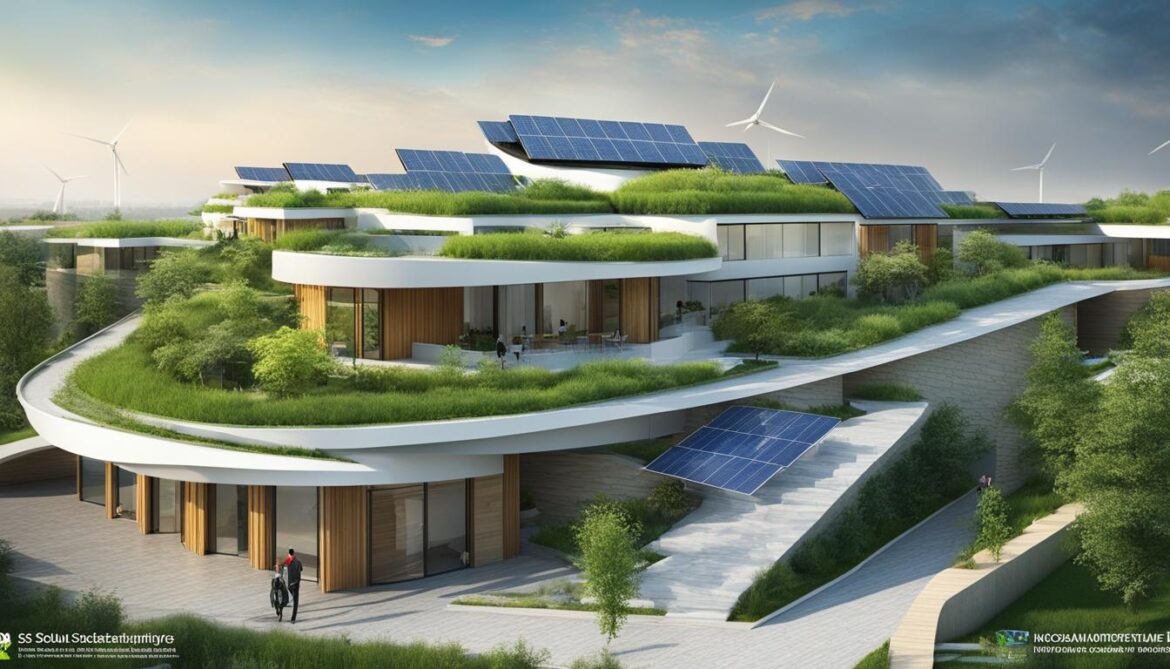
Sustainable Design and Materials in Kazakhstan’s Green Buildings
Kazakhstan’s top green buildings prioritize sustainable design principles, incorporating features such as passive heating and cooling, natural lighting, and water conservation measures. Passive heating and cooling systems utilize natural resources to minimize reliance on traditional systems, reducing energy consumption and cost savings. Natural lighting reduces the need for artificial lighting and creates a more comfortable indoor environment. Water conservation measures, including rainwater harvesting systems and efficient plumbing fixtures, minimize water consumption and support the reuse of wastewater. Locally sourced materials are chosen for their low environmental impact, promoting sustainability and supporting the local economy.
Benefits of Sustainable Design and Materials
- Reduces energy consumption
- Cost savings
- Improves indoor comfort
- Minimizes water consumption
- Supports local economy
By prioritizing sustainable design and materials, Kazakhstan’s green buildings offer numerous benefits. The use of passive heating and cooling systems, natural lighting, and water conservation measures not only contribute to a more sustainable environment but also result in energy and cost savings for building owners. Additionally, locally sourced materials support the local economy and reduce the carbon footprint associated with transportation.
“The integration of sustainable design principles demonstrates Kazakhstan’s commitment to eco-conscious construction and environmental stewardship.” – Architectural Digest
Furthermore, sustainable design goes beyond environmental considerations. It also enhances the well-being and comfort of building occupants, creating healthier indoor environments that promote productivity and well-being. With sustainable design and materials at the forefront, Kazakhstan’s green buildings serve as inspiring examples for other countries to follow in the pursuit of a greener future.
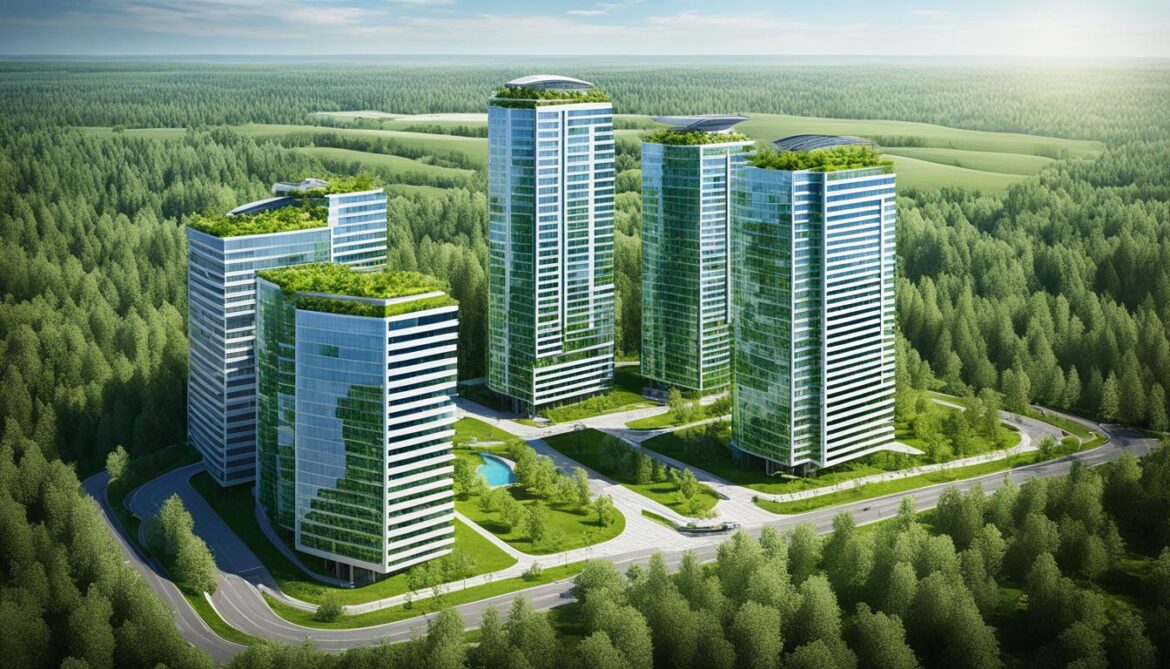
Sustainable Features in Kazakhstan’s Green Buildings
| Feature |
Description |
| Passive heating and cooling systems |
Utilize natural resources for temperature regulation, reducing energy consumption |
| Natural lighting |
Maximize the use of natural light to reduce the need for artificial lighting |
| Water conservation measures |
Include rainwater harvesting systems and efficient plumbing fixtures to minimize water consumption |
| Locally sourced materials |
Chosen for their low environmental impact and to support the local economy |
Eco-Conscious Urban Development and Sustainable Cities in Kazakhstan
In their quest for sustainable development, Kazakhstan is prioritizing eco-conscious urban development and integrating green buildings to create cities that prioritize the well-being of residents. This commitment to sustainable cities is driven by the Kazakhstan Green Building Council (KazBC) and the United Nations Development Program (UNDP), who play crucial roles in promoting eco-friendly construction practices and advocating for the integration of green buildings.
A shining example of sustainable construction in Kazakhstan is the Mega SilkWay shopping center in Astana. This architectural marvel incorporates cutting-edge energy-efficient systems and green design elements to minimize its environmental impact. By implementing these eco-friendly technologies, the Mega SilkWay shopping center not only contributes to the reduction of pollution but also showcases the potential for sustainable construction practices in the country.
The creation of sustainable cities goes beyond green buildings. Integrated urban planning in Kazakhstan includes the establishment of green spaces, efficient public transportation systems, and the utilization of renewable energy sources. These efforts aim to reduce pollution, improve air quality, and enhance the overall quality of life for residents.
By prioritizing eco-conscious urban development and sustainable cities, Kazakhstan is leading the way in creating a greener future. The collaboration between the Kazakhstan Green Building Council, the United Nations Development Program, and other stakeholders is vital in driving the transformation towards more sustainable urban environments.
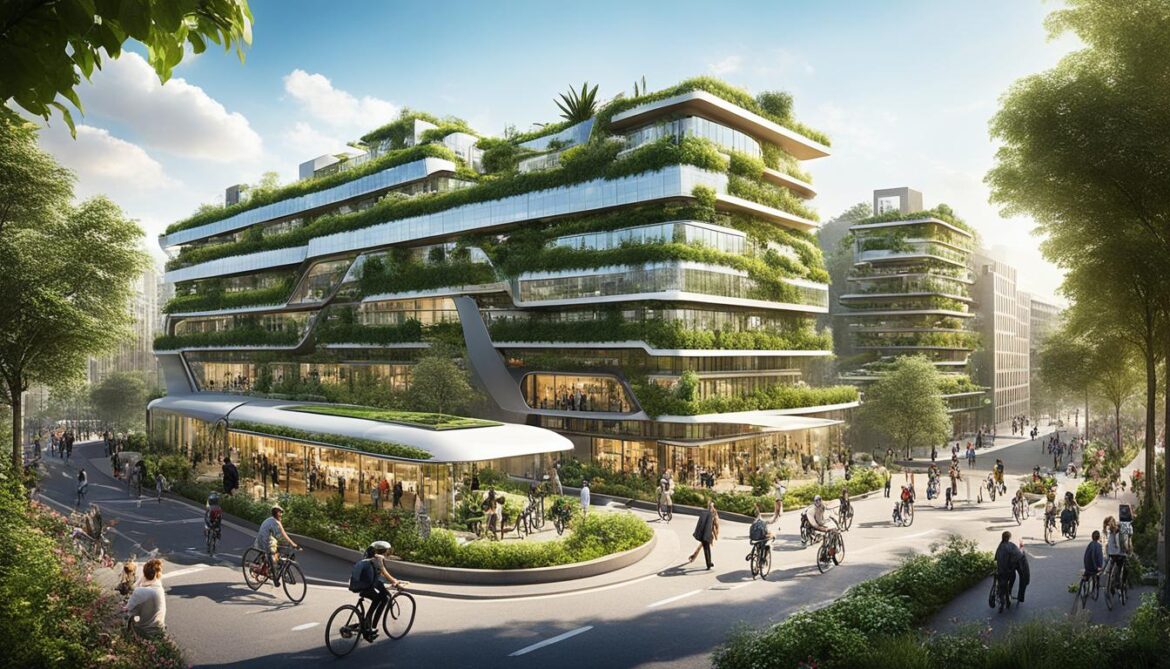
Benefits of Eco-Conscious Urban Development and Sustainable Cities
Eco-conscious urban development and the creation of sustainable cities offer numerous benefits for the environment, economy, and society.:
| Benefits |
Description |
| Environmental Preservation |
Reduced carbon emissions, improved air and water quality, and the preservation of natural habitats and biodiversity. |
| Economic Growth |
Creation of green jobs, increased investment opportunities, and cost savings through energy-efficient practices. |
| Social Well-being |
Improved quality of life, enhanced public health, and the promotion of community engagement and connectivity. |
Kazakhstan’s Efforts in Biodiversity Conservation
Kazakhstan is actively involved in the conservation of biodiversity, receiving support from the United Nations Development Program (UNDP). Through UNDP projects, significant contributions have been made to the conservation of globally significant ecosystems, including the establishment and expansion of protected areas.
One of the key strategies employed by Kazakhstan is the creation of ecological corridors and the introduction of ecosystem approaches in protected areas. These measures enable the conservation of rare and endangered species by providing them with suitable habitats and facilitating their movement between protected areas.
In addition to on-the-ground conservation efforts, Kazakhstan has taken a proactive approach at the policy level. The country has developed a state policy for the conservation and sustainable use of biodiversity, which includes the preparation of a strategic document and amendments to legislation. These actions demonstrate Kazakhstan’s commitment to long-term biodiversity conservation and sustainable development.
“Conservation is not a luxury, but a necessity for the future of our planet. By implementing these conservation measures and working in partnership with the UNDP, Kazakhstan is making a significant contribution to global biodiversity conservation efforts.” – [Name], Biodiversity Conservation Expert
Protected Areas in Kazakhstan
Kazakhstan is home to a diverse range of protected areas, which play a crucial role in conserving the country’s unique biodiversity. These protected areas include:
- – Altyn-Emel National Park
- – Aksu-Zhabagly Nature Reserve
- – Korgalzhyn Nature Reserve
- – Ile-Alatau State National Nature Park
- – Charyn Canyon
These protected areas serve as important habitats for a wide variety of plant and animal species, some of which are found nowhere else in the world. They also provide opportunities for scientific research, outdoor recreation, and eco-tourism, contributing to the local economy.
| Protected Area |
Location |
Key Features |
| Altyn-Emel National Park |
Ili District, Almaty Region |
Home to the famous Singing Dune and a diverse range of wildlife |
| Aksu-Zhabagly Nature Reserve |
Zhambyl Region |
One of Kazakhstan’s oldest nature reserves, known for its floral diversity |
| Korgalzhyn Nature Reserve |
Akmola and Karaganda Regions |
An important wetland area and a key breeding ground for migratory birds |
| Ile-Alatau State National Nature Park |
Almaty Region |
A mountainous park with diverse plant and animal species, including the endangered snow leopard |
| Charyn Canyon |
Almaty Region |
A breathtaking canyon known for its unique rock formations and picturesque landscapes |
These protected areas, along with many others in Kazakhstan, serve as vital ecosystems and contribute to the overall biodiversity conservation efforts in the country.
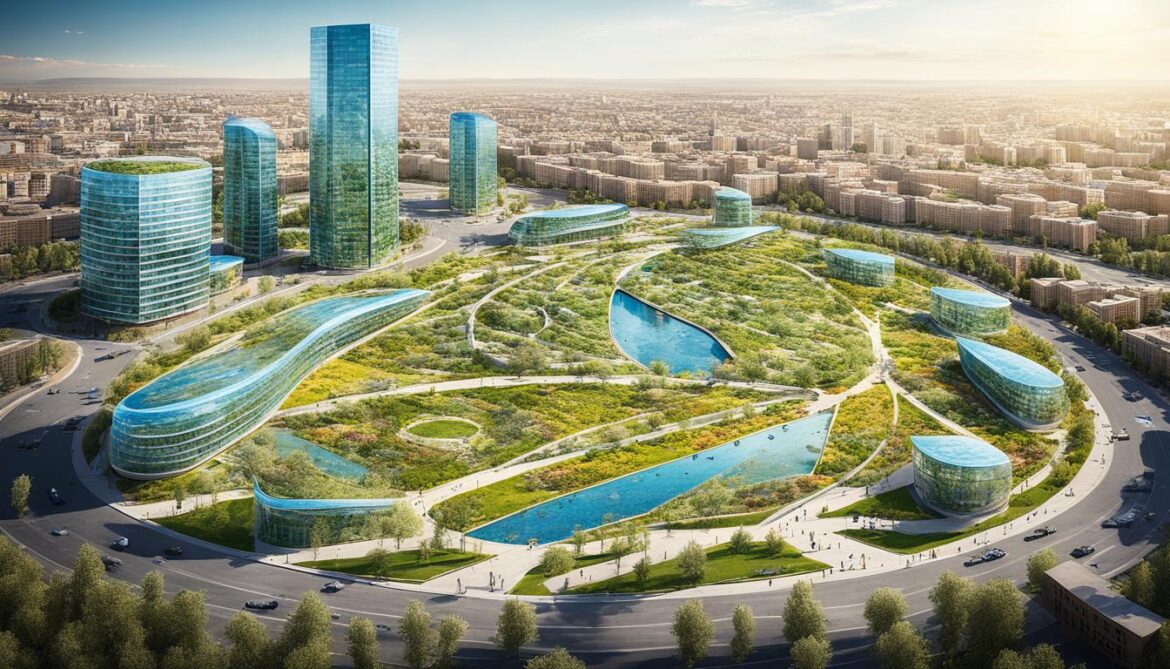
Conservation Successes and Challenges in Kazakhstan
UNDP projects in Kazakhstan have shown promising results in the realm of biodiversity conservation and sustainable ecosystem management. These initiatives have introduced innovative approaches to landscape planning, fostering the protection of natural habitats and creating opportunities for environmental engagement. Notable pilot projects have been implemented across various sectors, including pasture management, agriculture, reforestation, and ecotourism, with the aim of promoting sustainable practices and preserving Kazakhstan’s unique biodiversity.
While these conservation efforts have yielded positive outcomes, they also face significant challenges that require attention and proactive solutions. Limited government support poses a hurdle to the scalability and long-term viability of these projects. Additionally, the high costs associated with implementing conservation measures can be a barrier to widespread adoption. Furthermore, market demand for sustainable products and practices needs to be further stimulated to ensure the sustainability of conservation initiatives.
However, stakeholders within the industry are actively collaborating to overcome these challenges and drive progress in biodiversity conservation. Partnerships between governmental agencies, non-profit organizations, local communities, and international entities such as the UNDP have been instrumental in addressing these obstacles. Through collaborative efforts, these stakeholders aim to secure stronger governmental support, identify innovative financing mechanisms, and raise awareness about the importance of biodiversity conservation among the public.
Elevating the importance of biodiversity conservation and sustainable practices is vital not only for the preservation of Kazakhstan’s natural heritage but also for the well-being of current and future generations. By embracing the challenges and building upon the successes achieved so far, Kazakhstan is positioning itself as a leader in biodiversity conservation and setting an example for other nations to follow.
The Role of UNDP in Biodiversity Conservation
The United Nations Development Program (UNDP) plays a vital role in supporting biodiversity conservation efforts in Kazakhstan. With a focus on protecting unique nature and globally significant ecosystems, UNDP has implemented various initiatives that contribute to the preservation of biodiversity in the country.
Through these initiatives, UNDP has introduced innovative mechanisms for landscape planning, sustainable ecosystem management, and community development. These efforts are crucial in ensuring the long-term viability of biodiversity conservation projects and creating a harmonious balance between human activities and nature.
“The protection of biodiversity requires a multi-faceted approach that combines scientific expertise, community involvement, and financial mechanisms. UNDP’s initiatives in Kazakhstan demonstrate the organization’s commitment to creating sustainable solutions that promote the coexistence of humans and nature.”
One notable initiative is the Eco-Damu Microcredit Program, developed in collaboration with the Fund of Financial Support for Agriculture and the Forestry and Wildlife Committee. This program provides low-interest loans to rural residents living near protected areas, enabling them to explore alternative activities that are environmentally friendly and economically sustainable.
By supporting community development projects, UNDP fosters a sense of ownership and responsibility among local residents, encouraging their active participation in biodiversity conservation efforts. Furthermore, these projects create opportunities for sustainable livelihoods, reducing dependence on activities that may harm the environment.
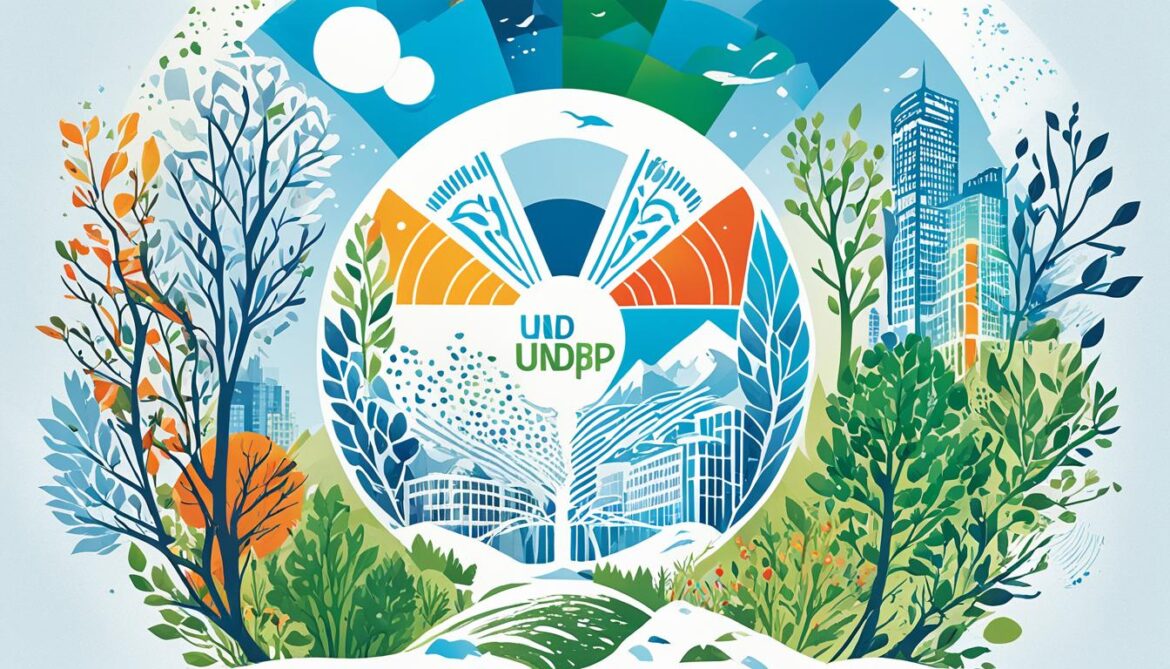
Financial Mechanisms for Biodiversity Conservation
To ensure the continuity and success of biodiversity conservation projects, financial mechanisms are crucial. UNDP’s involvement in Kazakhstan includes exploring innovative ways to secure funding for conservation initiatives. This includes leveraging public-private partnerships, securing funding from international organizations, and advocating for sustainable investment practices.
By aligning financial mechanisms with conservation objectives, UNDP aims to create a sustainable financing model that supports ongoing biodiversity conservation efforts. This approach strengthens the resilience of ecosystems and facilitates the long-term protection of biodiversity in Kazakhstan.
Conclusion
Kazakhstan has exhibited a strong commitment to integrating biodiversity conservation into the built environment, fostering sustainable development through green building initiatives. The country’s dedication to sustainable construction practices, utilization of green technologies and materials, and the creation of sustainable cities serve as an inspiration for nations in the region and beyond. This transformation towards a greener future is only possible through collaborative efforts between the Kazakhstan Green Building Council, the United Nations Development Program, and various stakeholders.
By placing a priority on sustainable construction practices, Kazakhstan is leading the way in promoting environmental consciousness and eco-friendly design. The government’s ambitious goal of generating 30% of domestic electricity from renewable sources by 2030 demonstrates its commitment to environmental responsibility. Notable green building achievements, such as the BREEAM-certified Park View Office and Q-2 building, showcase Kazakhstan’s exceptional progress in sustainable architecture.
Through the integration of green building initiatives, Kazakhstan is striving to strike a balance between urban development and wildlife preservation. The establishment of protected areas, ecological corridors, and the implementation of ecosystem approaches are crucial steps towards conserving biodiversity. Kazakhstan’s state policy for the conservation and sustainable use of biodiversity further highlights the country’s dedication to preserving its natural heritage.
In conclusion, Kazakhstan’s relentless pursuit of sustainable development, embracing green building initiatives, and the integration of biodiversity into its built environment demonstrate the nation’s commitment to a greener future. By setting an example for other countries through their achievements and ongoing efforts, Kazakhstan plays a pivotal role in driving the transformation towards a more sustainable and environmentally conscious world.
FAQ
What is the focus of Kazakhstan’s green revolution in the built environment?
Kazakhstan’s green revolution in the built environment focuses on sustainable construction practices, eco-conscious design, and the integration of green buildings to create sustainable cities.
What is the goal of the government in terms of renewable energy?
The government aims to generate 30% of domestic electricity from renewable sources by 2030.
What is the role of the Kazakhstan Green Building Council (KazBC) in promoting sustainable architecture?
The KazBC collaborates with the United Nations Development Program (UNDP) to develop green building standards and promote sustainable architecture in Kazakhstan.
Which buildings in Kazakhstan have received BREEAM certification for sustainable construction practices?
The Park View Office and Q-2 building in Kazakhstan have both received BREEAM certification, showcasing the country’s dedication to green building initiatives.
What are some examples of green construction technologies used in Kazakhstan’s green buildings?
Green construction technologies used in Kazakhstan’s green buildings include energy-efficient systems, passive heating and cooling, smart energy management systems, and sustainable materials.
What are the benefits of implementing green construction technologies in buildings?
Green construction technologies offer benefits such as reduced energy consumption, cost savings, enhanced comfort for occupants, minimized carbon footprint, and improved aesthetics.
What sustainable design principles are prioritized in Kazakhstan’s green buildings?
Sustainable design principles in Kazakhstan’s green buildings include passive heating and cooling, natural lighting, water conservation measures, and the use of locally sourced materials.
How does Kazakhstan integrate green buildings into eco-conscious urban development?
Kazakhstan integrates green buildings into eco-conscious urban development by prioritizing the well-being of residents, incorporating green spaces, efficient public transportation systems, and renewable energy sources to reduce pollution and improve air quality.
What efforts has Kazakhstan made in biodiversity conservation?
Kazakhstan is actively involved in biodiversity conservation efforts, with support from the United Nations Development Program (UNDP). They have established new protected areas, expanded existing ones, and implemented ecosystem approaches and ecological corridors to protect rare and endangered species.
What challenges do biodiversity conservation projects in Kazakhstan face?
Biodiversity conservation projects in Kazakhstan face challenges such as limited government support, high costs, and market demand. However, stakeholders in the industry are actively working to address these challenges and promote sustainable construction practices throughout the country.
What is the role of the United Nations Development Program (UNDP) in biodiversity conservation in Kazakhstan?
The UNDP plays a key role in biodiversity conservation efforts in Kazakhstan through various initiatives focusing on landscape planning, sustainable ecosystem management, community engagement, and the development of financial mechanisms to support conservation activities.
Source Links






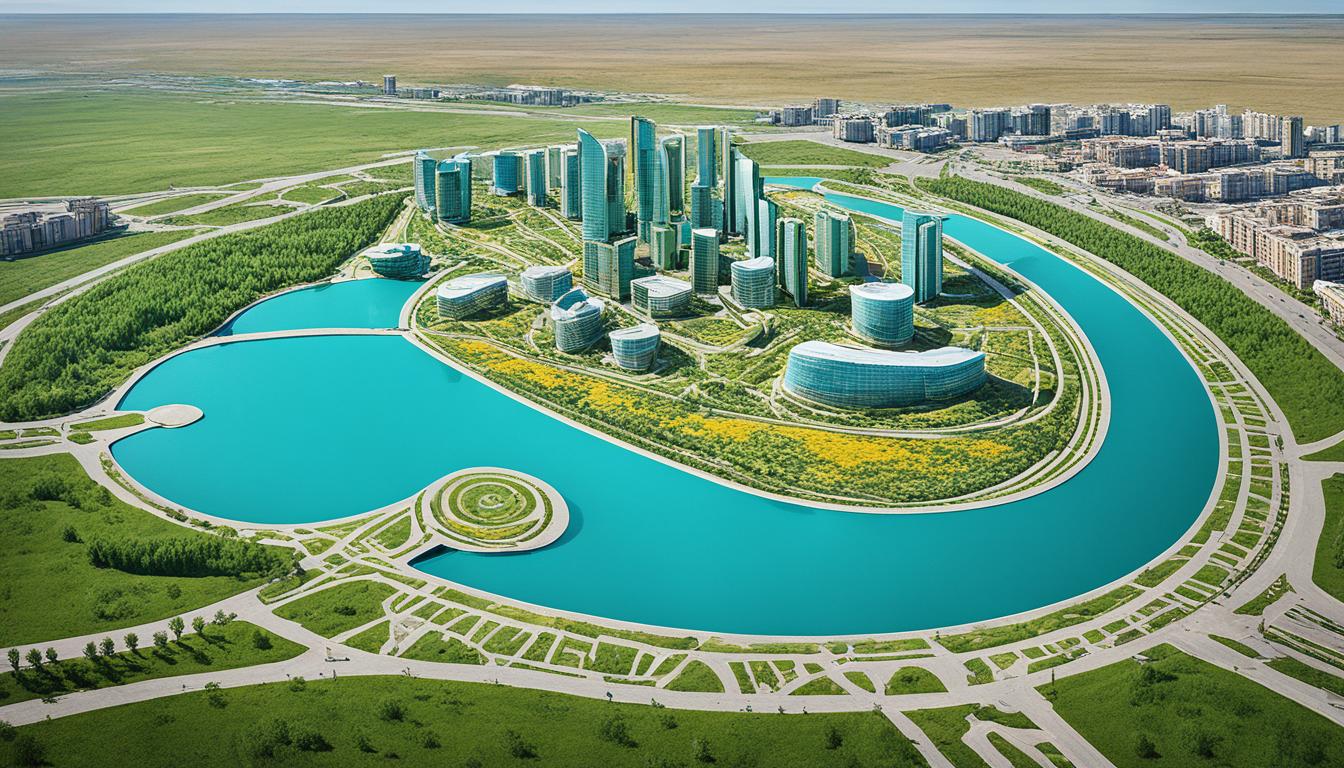

















Post comments (0)